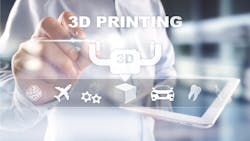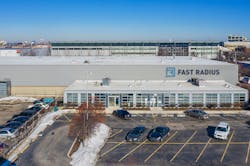Microfactories Offer a Large-Scale Design Opportunity
In January, Fast Radius announced the opening of a microfactory and software technology center on Chicago’s Goose Island. The new Fast Radius facility, its second in Chicago, is looking to build on the company’s successful efforts in scaling manufacturing from design to fulfillment. The microfactory also is located near MxD, the public-private digital manufacturing consortium. The new facility will produce components for companies across industries, including automotive, electric vehicles, medical and healthcare devices, and consumer goods.
Bobby Bott, the VP of manufacturing at Fast Radius, talked with Machine Design about the concept of a microfactory, the future of additive manufacturing, and the opportunities and limits of 3D manufacturing on the plant floor:
Machine Design: The concept of your microfactories in Chicago seems to be part test bed, part manufacturing prototype. As you’ve developed the microfactory, what are some of the key takeaways that have led to improvements in the concept?
Bobby Bott: Over the last five to six years, we have been perfecting our microfactory playbook, and now we’re able to stand them up and scale them easily. In building our playbook, we have seen the need for facilities to provide customer solutions around safety, quality and cost—so that’s what we created.
We now have multiple microfactories in Chicago, with locations in the West Loop and Goose Island, along with a microfactory at UPS’ Worldport headquarters in Kentucky.
Our Custom Microfactory Solution is a newer offering that allows companies to partner with Fast Radius to design and stand up advanced microfactories. Each factory is designed to meet a customer’s specific component manufacturing and technology needs, along with giving them access to proprietary software tools that provide visibility and insight into factory and supply chain operations.
Our microfactories will continue to expand around the world, enabling customers to ship parts digitally and produce goods locally where and when they are needed, dramatically reducing waste and improving access.
MD: The microfactory combines CNC machining and additive manufacturing. Five years ago, those disciplines seemed at odds with one another. What’s changed in the last five years?
BB: Yes, the microfactories in our Goose Island campus feature CNC machining and additive technologies. We believe that there’s not one right manufacturing technology that’s a one-size-fits-all. Our customers are designing and making a range of parts, and each technology has its own specialty.
In fact, that’s one of the benefits of our Fast Radius Cloud Manufacturing Platform. Customers can explore different materials and manufacturing technologies, ultimately choosing the best techniques for any given part. Our technology-agnostic approach allows us to provide the right solution to our customers’ application, and we are consistently evaluating and on-boarding new capabilities into our platform to broaden our offerings.
MD: Manufacturing has surged in the last 18 months, but the two greatest drags on manufacturing expansion have been supply chains and workforce staffing. How can microfactories address these issues?
BB: The inefficiency in global supply chains today is significant. We built Fast Radius to bring manufacturing and supply chains into the digital age. We’re designing, making and moving things for the physical world by harnessing the power of the digital world. Cloud manufacturing allows for many of the same benefits of just-in-time manufacturing but with more reliability, sustainability and flexibility.
Instead of centralized mega-factories, the microfactory model is localized, meaning it places manufacturing production closer to both the end-user and logistics epicenters. This removes both waste and supply chain interruption risks that we’ve all seen related to transit, tariff and duty challenges.
Microfactories are also software-enabled and highly scalable. As our microfactory network expands around the world, we can ship parts digitally and produce parts when and where they are needed, dramatically reducing waste, improving access and producing locally. It’s a new supply chain paradigm.
MD: That said, what are the limits of a microfactory deployment in manufacturing? Are there certain industries that might benefit more from this concept?
BB: Any manufacturer can benefit from a microfactory. At Fast Radius, our customers leveraging our microfactories come from across many diverse industries, including traditional automotive, EV, medical/healthcare, consumer goods and aerospace. The value proposition for our customers is centered in creating parts closer to their consumption/assembly, therefore alleviating overseas headaches, supply chain disruptions and tariffs. Customers also benefit from decreased carbon footprint, improved lead times and flexibility in production, whether it be on-demand, scaling up or down, etc.
Of course, in many of these industries mentioned there are certification requirements (such as before a part is installed on a plane). Fast Radius has developed a quality management system that our customers can leverage to make certified parts that actually go on the end product from start to finish.
MD: Fast Radius’ new facility in Chicago is very close to MxD. Where are the benefits on both sides to that geography?
BB: MxD was founded on the premise of digital innovation in manufacturing. A goal which finds tremendous alignment and history with our mission to make new things possible through our Cloud Manufacturing Platform. As we are driven by similar goals and draw kindred interest to further the industry, we play well off each other. Our synergistic locations create a destination for industry and innovation leaders to collaborate together.
MD: 3D printing has gone from simple prototyping to wide adoption and integration into the entire design-manufacture lifecycle. What’s next?
BB: Additive is one of our current capability pillars and we believe that advancements will continue to be made in materials, finishing, speed and cost competitiveness. Our goal is to push our capabilities further to service our new and existing customers with the right manufactured solution—our Cloud Manufacturing Platform. This Platform offers the ability for anyone located anywhere in the world to have access to tools that allow them to better design, make, move and store parts.
We have our current microfactories, our future aspirations and are continuously evaluating our existing offerings as we look to grow our portfolio capabilities within our Cloud Manufacturing Platform.
About the Author

Bob Vavra
Editor Emeritus, Machine Design and Power & Motion
Bob Vavra is the former senior content director of Machine Design and Power & Motion.

